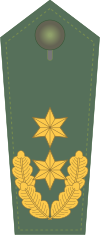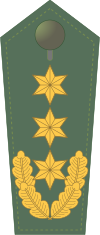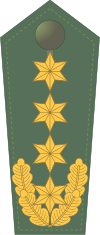Chief of Police
The police chief is the head of a police institution or an association. The job description is different depending on the state. In Switzerland, the head of a police corps has the title of police commander .
Germany
In Germany, the chief of police (is abbr. PP or PPR) in the German police of the head of an authority of a United Federation of Police , mostly of a police headquarters . Police President and Police Vice President are official titles in some positions in most federal states .
Depending on the federal state, police presidents are subordinate to the respective regional president , the police inspector or the interior minister or interior senator or president of the interior affairs department and are obliged to report to them. The characteristics of the civil servant relationship in the federal states are very different: in some they are police officers and wear uniforms , in others they are administrative officers and in some cases also wear uniforms. The heads of the police administration offices, training institutions, etc. are generally not law enforcement officers. In Berlin , the entire state police is called The Police President in Berlin , because the staff and the authority as such act in its name (order).
tasks and activities
Police chiefs, as top officials, are responsible for all operations in their area of responsibility; they are the highest representative of their police headquarters. They are usually also the superior of the employees who report to them, but in any case the superior .
In addition to police activities such as surveying the situation, analyzing and coordinating the departments, administrative activities such as organization, process planning, human resources (including official assessment of subordinate officials and employees) and budgeting are his area of responsibility. He is usually given the opportunity to regulate specifications from superior departments on his own responsibility.
As a rule, there is a management staff in the police chief's office and occasionally also an office (e.g. presidential office). Police presidents are part of the authority management in their original function, depending on their assignment.
The representation of the police chief is regulated differently. In some federal states, the following applies: The permanent representative of the Police President is the head of the Deployment Department as Police Vice President (PVP). If the chief of police and his deputy are absent at the same time, the senior head of the operations department represents them. Another substitute occurs outside of office hours: The substitute is performed by the senior civil servant from the service (HvD).
In some federal states the representative is the chief police director / chief criminal director.
Education, requirements
Police chiefs are senior civil servants . Direct access is usually not possible or at least not common. This does not apply to the federal states in which the police chief is a political officer (e.g. North Rhine-Westphalia ).
Salary
The salary of the police presidents in Germany is a matter of the state. It ranges from grade A16 to groups B-grades B5, B6 and in Berlin B7.
Rank badge
The basic design of the shoulder pieces is uniform nationwide for all police forces (since 1976 with the police forces of the federal states , between 2001 and 2005 with the Federal Border Guard ). What they all have in common is a golden star that is (mostly) partially enclosed by oak leaves.
| Police chief rank badge | |||
|---|---|---|---|
| fig. 1 | fig. 2 | fig. 3 | fig. 4th |
- Legend
- fig. 1: Department director at the Frankfurt am Main police headquarters; Director of the riot police (Brandenburg, Hamburg, Lower Saxony, Rhineland-Palatinate, Saxony-Anhalt); Director ( Police President Berlin ); Director of the Institute for Education and Training (North Rhine-Westphalia); Police President as head of a police department (Saxony); Police President as head of the presidium of the riot police (Saxony); Police President as head of the State Police Directorate Central Services (Saxony); Police Vice President (Baden-Württemberg, Bavaria ); Vice President of the Riot Police (Hesse); Department President in the Federal Police
- fig. 2: Police President (Baden-Württemberg, Bavaria, Mecklenburg-Western Pomerania (since March 1, 2011)), Police Inspector (Brandenburg, Hamburg, Hesse, Mecklenburg-Western Pomerania (until February 28, 2011), North Rhine-Westphalia, Rhineland-Palatinate , Saxony); State Police Director (Baden-Württemberg as a department head in the State Police Headquarters, Lower Saxony, Schleswig-Holstein, Saarland) State Protection Police Director (Berlin (until July 2003), Saxony-Anhalt); First director at the police chief in Berlin as head of staff; Director of the Federal Police Directorate
- fig. 3: President of the riot police (Hessen); Inspector of the riot police of the federal states ; State Police Director in Berlin (until 1993); President of a Federal Police Headquarters ; Police President of Saxony; Police Inspector (Baden-Württemberg, Mecklenburg-Western Pomerania (since March 1, 2011), Hesse, Bavaria (since November 11, 2013)); Police Vice President (Berlin).
- fig. 4: President of the Federal Police Headquarters ; State Police President (Baden-Württemberg, Bavaria, Hesse (since 2011)); Police President (Berlin).
In the case of “major locations” , the chief of police is usually the chief of the police , whereby the organizational structure of the department or the state police is important. Police presidents of authorities with a very large service district perform this task less often than those of authorities with a small service district.
Austria
Only the head of the ( kk ) Police Directorate Vienna, since 1920 the Federal Police Directorate Vienna , was designated as Police President in Austria - from 1873 until the security authorities were restructured in 2012 . The deputy chief of police was referred to as the chief of police. Since September 1, 2012, the head of the Vienna State Police Directorate has held the title of State Police President , his deputy the title of State Police Vice President .
The heads of the other federal police departments in Austria carried the usage designation Police Director until these departments were dissolved on September 1, 2012 and are now state police directors. The since 1873 different name in Vienna underlined the special position of Vienna as kk imperial capital, later federal capital.
Gerhard Pürstl has been the Police President and now the State Police President of Vienna since January 1, 2008 .
history
The title of Police President was first bestowed by Emperor Franz Joseph I on Anton Ritter von Le Monnier on June 7, 1873, ten days before Le Monnier's death. The first head of the Vienna Police Directorate who actually held the title of president was Wilhelm Marx von Marxberg . Before that, the designation police director was also used in Vienna . Links to all Viennese police presidents can be found using the navigation bar built into the presidential lemmas.
One of Vienna's best-known (and most controversial) police presidents, Johann Schober , who was Chancellor three times in the First Republic , was appointed head of the Vienna Police Department by the last emperor, Karl I , on June 11, 1918, five months before the monarch's resignation . His appointment as police president came about on November 30, 1918 in the republican German Austria by the Renner I state government. In the Second Republic, the police chief Josef Holaubek , who appeared almost exclusively in civilian clothes, became legendary.
Names of traffic areas
In Vienna three traffic areas and one bridge have been named after former police chiefs:
- 13. , Dr.-Schober-Straße : named in 1932 after the Police President and Federal Chancellor Johann Schober
- 9. , Nordbergstrasse (near Franz-Josefs-Bahnhof ): named in 1899 after Karl Noé Edler von Nordberg, Prince Metternich's secret service chief ; after positions in Vienna, Mainz , Frankfurt , Innsbruck and Linz from February 1849 to December 1850 city governor (police director) of Vienna
- 9., Nordbergbrücke ( 1978/1982 ; connecting bridge between Spittelauer Lände and Josef-Holaubek-Platz ): see Nordbergstrasse
- 9., Josef-Holaubek-Platz (between Nordbergbrücke and Liechtenwerderplatz ): Federal Office Building Josef-Holaubek-Platz Seat of the Federal Criminal Police Office , named in 2000 after the very popular police president Josef “Joschi” Holaubek in the 1970s
Rank badge
In 2008, a new distinction was created for the police chief as part of the new uniform. The rank badges previously used are now used by the General Director for Public Security , who previously did not have the right to wear a uniform.
See also
- List of Hamburg police presidents
- List of Munich police presidents
- Official titles of the German police (except federal police)
- Official titles of the German Federal Police
- Hanover Police Department
- Ranks of the Austrian security executive
Web links
Individual evidence
- ^ Website of the Conference of the Swiss Cantonal Police Commanders (KKPKS) , accessed on January 9, 2017.
- ↑ parldok.brandenburg.de (PDF; 66 kB)
- ↑ beamtstg.de .
- ↑ landesrecht-bw.de
- ↑ Thomas Hampel is the new inspector of the Bavarian police. In: stmi.bayern.de. Retrieved November 3, 2016 .
- ↑ In memory of ... - Several streets and alleys in Vienna are named after police officers. Five of them were murdered while on duty. In: Public Safety , 9–10 / 2007, pp. 67–68; Street names. (PDF; 315 kB; 2 pages) on BMI.gv.at ; Retrieved May 23, 2010.



